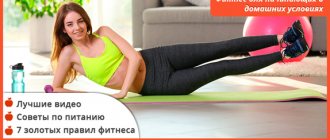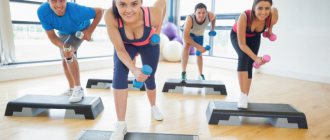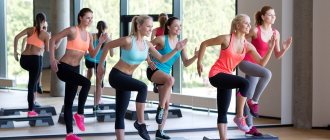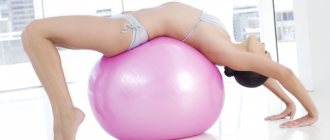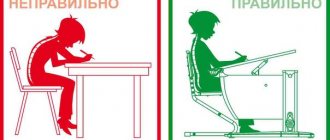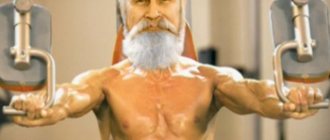Why aerobics is useful for children, what are the disadvantages, how much classes cost and how to choose a section - read in our article.
The word “aerobics” is on everyone’s lips. A complex of rhythmic movements accompanied by dance music immediately appears. Many people perceive aerobics as a sport for adults, aimed at combating excess weight, and which eliminates figure flaws. In fact, anyone can do aerobics, including children. A set of aerobic exercises is beneficial for a growing body: it strengthens posture; improves immunity, respiratory and cardiovascular systems; forms a healthy musculoskeletal system and improves coordination of movements.
What is fitness for children
This is a fairly new, yet already very popular area of physical education for children, which is based on strengthening and maintaining the health of children. In contrast to simple school physical education, such fitness, for example, step aerobics for children, is a system of various developmental sports activities that is designed for children of a certain age, in addition, it is a semblance of adult fitness, only in a “lighter” version.
In ordinary language, this is a certain set of activities that are designed to ensure that the child will strengthen physical health and immunity, and also spend his leisure time in an interesting and fun way. This is what aerobics for children is for. Experienced professionals develop programs seeking to instill in children a love of sports and a conscious desire to improve their health.
And since this is fitness for kids, the main tool for child development here is play. Almost all exercises contain game elements, special music for aerobics for children is selected, therefore, the child gets doubly pleasure: both has fun and develops.
Medical contraindications
Aerobics has virtually no contraindications. You can choose any combination of exercises in accordance with the child’s health condition and enroll in a specialized group. For example, high-impact exercises will be contraindicated for children with respiratory diseases, but swimming or yoga will be beneficial. General contraindications include only serious diseases of the heart, respiratory system, trauma, disorders of the musculoskeletal system, exacerbation of chronic, viral or infectious diseases.
Where to begin
Initially, consult your local pediatrician. If the child has chronic diseases, this will complicate the task somewhat, although it will not prohibit fitness activities. You will be offered to study according to a different program. For example, aerobics is contraindicated for an asthmatic child, but yoga is useful and, accordingly, acceptable. If a child has problems with the spine, strength training will have to be abandoned, although aerobics and swimming can fully compensate for them.
More about the price. The average cost of a month's stay for a child in the club at the moment will be about $80-100, not counting the cost of sportswear and other equipment - you will need to buy it at your own expense.
Next, we will present to you the main list of fitness areas for kids.
From what age
Aerobics is suitable for both small children and school-age children and teenagers. You can start doing it at any age, starting from 1-1.5 years. Exercises will be selected depending on age characteristics. For young children, activities in the form of games are possible.
Conventionally, age groups can be divided as follows: children under 3 years old, preschool age and schoolchildren.
For the little ones, exercises should be simple: walking, squats. It is recommended to practice for no more than 10 minutes. For older children, the exercises may be more complex, including strength training and dance aerobics and lasting 20-30 minutes. You can add elements of yoga, step and exercises with objects, such as a ball or body bar.
Children usually do aerobics 1-2 times a week, older children - 2-3 times.
How to choose a section
Look on the Internet to see which fitness clubs or children's sports complexes located near your home offer aerobics classes. Read reviews, go to a trial lesson, talk to a coach or other parents. Under no circumstances force your child to study if he doesn’t want to or is tired. Classes should be fun. The important thing is to interest him and make playing sports an exciting event. Then the child will only benefit from sports.
Children's workouts: how to choose fitness for a child
“Children’s fitness is a system of activities aimed at the physical, creative, intellectual and harmonious development of the child,” explains Tatyana Rumyantseva, manager of the FizKult Rodionova children’s club. – In addition, properly designed programs not only provide prevention, but also help solve a number of important issues in children's health.
Diseases of the musculoskeletal system are one of the most popular problems in terms of the number of requests. The leading ones are various forms of poor posture and flat feet. Therefore, children's classes are aimed primarily at strengthening the muscles of the back, abs, lower legs and arch of the foot. Such training can begin at 3 years of age.
The next feature of children is frequent respiratory diseases. The solution is to include yoga with various breathing exercises in the children's fitness program. This, by the way, is a good prevention of asthma. These programs are designed for children aged 3-4 years.
Another, no less important, issue is various speech therapy disorders.
It is known that the higher the child’s motor activity, the better his speech. And special classes, for example “Theater of Hands,” are aimed at fine motor skills, which is directly related to the development of speech, thinking, imagination and even visual memory!” THUS, CHILDREN'S FITNESS CLASSES:
- aimed at developing rational motor skills, sensory and motor functions,
- prevention and correction of musculoskeletal disorders,
- acquiring proper breathing skills,
- development of the intellectual and emotional-volitional sphere
- providing additional physical activity for children
- development of social skills and formation of the habit of regular exercise.
In children's fitness, it is especially important that the groups are homogeneous in age and level of training. Therefore, in the FizKult network, lessons are compiled in accordance with the age, anatomical, physiological and psychological characteristics of children and are divided into five age groups.
“BABIES” FROM 6 MONTHS TO 3 YEARS OLD
For the “Toddlers” age group, it is very important that the first acquaintance with fitness takes place with the closest person - mom or dad. Parents help their child explore the world. And the coach focuses on developing basic motor skills.
“WHY” FROM 3 TO 5 YEARS OLD
In the “Pochemuchki” age group, the game method predominates. Games for children are a complex, multifunctional and educational process, and not just entertainment or a waste of time. Thanks to games, the child adapts to the world around him. Through play, a child develops physically, mentally and emotionally.
"FIDGE" 5-8 YEARS OLD
A special feature of the “Fidgets” age group is the active growth of the child. Therefore, it is very important to form and maintain correct posture. This problem is solved by the “Straightening”, “Olympic”, “Fitball” lessons, which strengthen the muscle corset. In addition, at the age of 6-7 years, it is important to prevent a decrease in flexibility - joint mobility and ligament plasticity. Girls are recommended to attend choreography and rhythmic gymnastics, boys – yoga.
"JUNIORS" 9-12 YEARS OLD AND "TEENAGERS" 13-16 YEARS OLD
“Juniors” and “Teenagers” are age groups in which it is important to improve coordination, motor skills, speed abilities and endurance. During this period, the participation of a trainer who can correctly distribute the load depending on the development of the respiratory, cardiovascular systems and muscles becomes especially important. We recommend attending Streetball, Football, and other game and team lessons.
pros
The benefits of aerobics for children are enormous. With its help, you can accustom kids to an active lifestyle and distract them from the “street” or computers. At the same time, children improve their health, become stronger and communicate with like-minded peers.
Aerobics helps prevent diseases that come with a sedentary lifestyle, such as excess weight or heart problems.
Preschoolers are easily excitable, and sports such as aerobics help direct their activity and excessive energy in the right direction.
Aerobics trains self-control. Older children are ready to handle more complex exercises. Thanks to this, such important qualities as endurance, effort and determination develop.
In terms of health, aerobics covers all important areas of the body:
- strengthens the muscular, skeletal and musculoskeletal systems;
- improves joint function;
- trains the respiratory system;
- increases immunity;
- forms correct posture;
- prevents flat feet due to the work of the muscles of the lower leg and foot and stagnant processes in the body;
- optimizes metabolism;
- improves coordination of movements, strength and endurance to physical activity;
- increases activity and cheerfulness.
Another advantage of aerobics is that it can be done outdoors. Moderate exercise in the fresh air is doubly beneficial.
For school-age children, aerobics helps relieve mental stress after school.
The importance of aerobics in the life of a preschool child.
Introduction………………………………………………………………………………….3
The importance of aerobics in the life of a preschool child……………………….………………4
Aerobics objectives………………………………………………………………..5
Formation of skills at different stages of training (middle group, senior group, preparatory group)……………………………………………………………………………………….…6
Conclusion………………………………………………………………………………..10
List of references…………………………………………………………………………………..…12
Introduction
Throughout history, people have been looking for ways and means for their comprehensive personal development and improvement. Even the ancient Hellenes, in order to “educate the body and spirit,” used a combination of music and movement – “orchestrika”, which made it possible to develop physical qualities, plasticity, beautiful posture, musical abilities, as well as aesthetic taste.
Aerobics or rhythmic gymnastics are very popular these days. It belongs to the health-improving types of gymnastics. Rhythmic gymnastics exercises are simple in their motor structure and accessible to children. This includes general developmental exercises, running, jumping, and dance elements, but performed in a more varied and emotional way. Rhythmic gymnastics is unique: there is pace, intensity of movements, work of all muscles and joints, cheerful rhythmic music, and bright clothes. All this creates positive emotions. It is no coincidence that rhythmic gymnastics has become so widespread throughout the world.
- The importance of aerobics in the life of a preschool child.
Rhythmic gymnastics - performing movements to music. Movements form the basis of children's activities. Limiting a child’s motor activity contradicts the biological needs of a growing organism. Physiologists consider movement to be an innate, vital human need. Its complete satisfaction is especially important in preschool age, when all the basic systems and functions of the body are formed.
Movement is a prevention of various kinds of diseases, especially those associated with the cardiovascular, respiratory, and nervous systems. Scientists, as a result of medical research, have come to the conclusion that lack of movement not only negatively affects the health of children, but also reduces mental performance.
Rhythmic activities are a form of pedagogical work when teaching children in kindergarten movements. Maximum effectiveness of classes can be ensured if children's activities are organized taking into account the principles of systematicity, accessibility, activity, and consciousness. The selection of musical accompaniment is carried out by selecting several musical genres (tape recordings with children's songs, modern popular and classical music).
When performing rhythmic gymnastics, one of the main tasks is solved - strengthening the health of preschool children.
The use of an unconventional technique - rhythmic gymnastics, helps to get the child interested in physical education and to form a need. And subsequently, the habit of doing physical exercise on your own, thereby attracting children to a healthy lifestyle. Insufficient motor mode is one of the reasons for the weakening of the child’s body. With the help of rhythmic gymnastics, it is possible to compensate for the lack of physical activity that is present in preschool institutions, primarily due to the large overcrowding of groups. Nowadays, there are a lot of hyperactive children who need additional physical activity. Systematic exercises have a beneficial effect on the activity of the central nervous system, on the development and strengthening of the muscular system. Circulatory and respiratory organs. Under the influence of exercise, muscle volume increases, their strength and elasticity increase. During exercise, the heart muscle develops and trains. A trained heart pushes a significantly larger portion of blood into the aorta with each contraction. Than untrained. The respiratory organs are strengthened and the volume of the chest increases. It is very important to monitor your breathing throughout the session. A deep breath should be taken in the phase of the exercise where the chest is expanded, and exhale when the chest is compressed.
2. Aerobics tasks
Aerobics for preschoolers allows you to solve the following problems:
- Forming the foundations of a culture of movements
- Development of basic physical qualities
- Developing body control skills, strengthening muscles
- Improving the functioning of the respiratory and circulatory organs
- Increased physical performance
- Formation of beautiful posture
- Cultivating a strong interest and need for physical education
- Improving the sense of rhythm
- Formation of skills in the middle group
When working with children aged 3.5 - 4.5 years, the following must be taken into account:
- Exercises should be accessible to children of this age.
- Musical and song accompaniment should encourage them to imitate movements and evoke an emotional response.
- It is necessary to exclude drill - children master the movements gradually.
- The display of movements must be mirrored.
- Children should exercise without shoes, otherwise it is impossible to strengthen the musculo-ligamentous apparatus of the foot.
- The complex must include exercises to strengthen the muscles of the arm, especially the hand and fingers.
- Gradually, you can introduce exercises that develop the ability to navigate in space (for example, from a standing position, scatter into a flock and return to your place; while standing still, raise your arms up, turn your body left and right).
- Exercises should be selected taking into account the need to develop voluntary attention, distribute it and expand the scope of attention (for example, take a basic stance, raise and lower your shoulders, keeping your hands down with your palms facing forward; rise and fall on your toes without bending your knees).
- It is best to develop motor voluntary memory through repeated repetition of familiar exercises.
Formation of skills in the senior group
I work with children of senior preschool age, you should remember:
- Children's movements become more meaningful, motivated and controlled.
- The ability to voluntarily regulate motor activity increases.
- Children can already force themselves to overcome difficulties when performing complex motor tasks and consciously perform tasks to move in space.
- Through movement, children learn about their body and its capabilities.
- Children's movements become more coordinated and confident, they quickly master complex coordination movements and maintain balance.
Solving these problems creates the prerequisites for complicating and expanding motor goals, rhythmic gymnastics classes, in which the teacher continues: to develop motor and muscle memory, attention, concentration, discipline; strengthen the back muscles and form correct posture, develop foot muscles, flexibility, strength, endurance and performance; work out performance; practice the purity and accuracy of movements, the ability to independently analyze the quality of movements performed; develop the desire to perform movements efficiently and beautifully; develop object dexterity by using various objects (hats, pistols, springs, etc.); introduce different genres of music and its characteristic movements; develop the ability to speak emotionally in front of an audience; liberate children emotionally through musical images.
Formation of skills in the preparatory group
Children of the school preparatory group (6 - 7 years old), who have completed the previous stages of education, can perform movements that are quite complex in coordination and tempo during rhythmic gymnastics classes. They are already efficient and hardy. Mental processes are included in the lesson consciously. Children develop objective ideas about their own capabilities. They are persistent in practicing and polishing movements. They are interested in learning more complex movements in coordination. They are able to work on a complex movement, achieving high-quality execution. They get upset when something doesn’t work out, and, conversely, experience great joy when a complex movement doesn’t work out.
The teacher needs to support the child when he has not mastered some element, instill confidence in him, explain mistakes and be sure to share with him the joy of achieving a result. When conducting a rhythmic gymnastics lesson, the teacher should focus on learning musical and sports compositions and developing in children the ability to perform in front of spectators, teach them motor actions with objects of increased coordination and sports orientation (complex acrobatic elements - a bridge on three points of support, rolls, somersaults, jumps, turns, etc.), teach changing formations and moving around the hall in different directions.
Musical material must be dynamic and rhythmic. With or without text, it doesn’t really matter; the main thing is that the selection of movements matches the nature of the music.
The selection of compositions is carried out differently for girls and boys. This is necessary for the development of elegance, grace, plasticity, elegance in girls, and masculinity, speed, strength in boys (girls perform with fans, scarves, boys with guitars, gymnastic sticks, etc.)
This approach to the development of motor abilities will not only teach children to move beautifully, give them the joy of feeling their body, self-confidence, but most importantly, it will instill a love for sports-oriented activities, physical exercise, and will give them the opportunity to successfully and with interest improve their motor abilities at any level. activities related to movement.
Conclusion
It is natural for a child to move from birth. By running, swimming, jumping, he satisfies the natural need for movement, although he does not realize the significance of this activity. Physical education and health activities should develop children physically, accustom them to consciously perform physical exercises, and form their idea of a healthy lifestyle. Aerobics helps solve all these problems.
List of used literature
1. Fairytale theater of rhythmic gymnastics // Doshk. upbringing. – 2004. – No. 5 – P. 36 – 37
2. Rhythmic gymnastics // Preschool. upbringing. – 2008. – No. 10 –
pp. 47 – 49
3. Rhythmic gymnastics in kindergarten // Preschool. upbringing. – 1993. – No. 9 – P. 29
4. Rhythmic gymnastics // Preschool. upbringing. – 2002. – No. 10 –
pp. 64 – 65
5. The importance of rhythmic gymnastics in the life of a preschool child // Preschool. upbringing. – 1996. – No. 6 – P. 61 – 63
Aerobics for children - benefits or harm
In recent years, modern parents have paid much attention to the physical and mental indicators of the child. Some send their baby to an early development group from birth to develop his mental abilities, while others, from the age of three, send their child to dance classes, sports clubs and fitness clubs to form a proper musculoskeletal system, improve immunity and other goals.
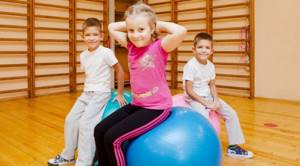
Aerobics for children
Children's aerobics is of considerable interest - an exciting and fun sport for children of any age and gender. Both boys and girls equally perceive aerobic exercise as an interesting game. At first glance, it seems that there might be something interesting about children doing the same exercises in class. In fact, lessons for kids are significantly different from those for adults. Each lesson is conducted under the guidance of an experienced trainer in a playful manner. Each time the kids go on a new exciting journey, where they perform various unique exercises that are beneficial to the health of all children, without exception. If it is not possible to send your child to an aerobic section, you can take advantage and go for a bike ride with the whole family.
Scientists have found that children who lead an inactive lifestyle will suffer from various pathologies of the nervous system in a few years. Therefore, undoubtedly, children's aerobics only has a beneficial effect on the general condition of the child. It has been proven that children who regularly engage in aerobics from early childhood develop their bone structure, speech and thinking much faster. Periodic physical activity on land and in water helps improve joint function, strengthen the respiratory system and all muscle groups. Prices for swimming pools are generally affordable for children and adults, so parents and their children are recommended to visit swimming pools and water parks as often as possible.
The benefit of aerobic training for children also lies in the fact that the child’s immunity in general increases, he gets sick less often compared to his peers who lead a sedentary lifestyle. Another important aspect of the consequences of regular children’s aerobics classes is the correct formation, development and subsequent improvement of all parts of the growing baby’s body.
Children who directly participate in sports programs such as dance, gymnastics, and acrobatics have a strong bone structure, which helps prevent various types of injuries in the future.
Boys and girls
There is no gender division in aerobics. There is something for everyone here. Girls especially like rhythmic dance movements, and boys cope well with exercises that require endurance. It also happens the other way around. It all depends on the personality and physical capabilities of your child.
Dance aerobics develops body flexibility, a sense of rhythm, and strengthens muscles. Step aerobics is suitable for children of all ages. The exercises are performed using a special platform; for children it is small - up to 10 cm in height, on which various combinations of steps are performed. Children learn to maintain balance and navigate in space. Develops speed, strength and agility. Sports children's aerobics contains exercises that are found in gymnastics, but only those that do not contain complex acrobatic elements. You can engage in this type of exercise no earlier than 5 years. Sports aerobics develops flexibility, plasticity, strength and endurance. Children acquire correct posture and learn to control their body.

